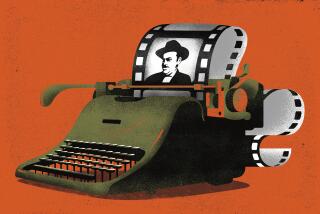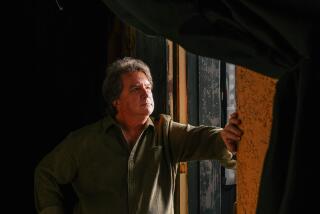TV Museum Unearths Welles’ ‘Fountain of Youth’ Show
- Share via
Orson Welles never played it safe. But then most geniuses never do.
At the ripe old age of 23, he paralyzed the nation with fear with his radio presentation of H.G. Wells’ “The War of the Worlds.” During his early 20s, Welles and his Mercury Players turned the stage world on its ear with fresh and often controversial productions. And at the age of 25, he starred in, co-wrote and directed arguably the greatest film ever made, “Citizen Kane.”
Though most people remember Welles’ TV work primarily for his Paul Masson commercials and appearances on the old “Merv Griffin Show,” the auteur had grand plans for the small screen back in the early years of the medium.
In 1956, he wrote, directed, produced, hosted, narrated and served as production designer and musical arranger for a series pilot called “The Fountain of Youth.” Though the series never sold, the 30-minute comedy ended up winning a Peabody Award.
This rarely seen pilot will be screened today through May 21 at the Museum of Television & Radio in Beverly Hills. Also on the program is Welles’ appearance on “I Love Lucy,” which led to the pilot, and a 1955 interview with Edward R. Murrow.
In conjunction with the screenings is a seminar on Welles, which will be held at the museum on May 16.
“This is something we wanted to acquire about three years ago,” says museum curator Allen Glover. “We were told by Paramount that legal issues surrounding this piece would be impossible to untangle and we would do best to forget it. It was originally an Orson Welles production, then the rights reverted to Desilu Production at one point and then back to Paramount and then back to Orson Welles. We spent three years trying to untangle it and now we have it.”
“Fountain of Youth” was first conceived when Lucille Ball, who knew Welles from their days at RKO studios, asked Welles to do a guest shot on “I Love Lucy.” Welles had just returned to the U.S. after spending several years in Europe and was eager to get his career back on track.
During the filming of “I Love Lucy,” Welles pitched an idea for a series to Ball and Desi Arnaz, who ran Desilu Productions. “The Orson Welles Show” was to be a mixture of magic, interviews, dramatic readings and adaptations of classic tales. For the pilot, Welles picked John Collier’s short story “A Youth From Vienna.”
“Fountain of Youth,” Glover says, “hints at [Welles’] love for magic, the way that shots are set up and the use of mirrors and smoke and revolving cameras. It’s played as one big joke.”
Rick Jason, Joi Lansing and Dan Tobin star in this wryly amusing tale about love and the search for eternal youth.
But the real star of the show is Welles, who serves as narrator of the stylistic comedy, which features manipulative lighting, fake backdrops, stills and dialogue interwoven with the narration.
The special effects, says editor Dann Cahn, were ahead of their time. “Nothing was digital,” he says. “The special effects were done on an optical printer. Welles comes in and out of the story and actually mouths the words of the actors. It’s brilliant and timeless.”
Jason (“Combat”) recalls that Welles was a perfectionist on the set. “He had been given five days to do this thing by Desi and he brought it in in eight and half days. Most of it was rehearsing, very little was shooting because he would do it over and over again because it had to be precise. There was ranting and raving and screaming and yelling. He was a monster.”
Arnaz, Jason says, would frequently pop down on the stage to observe the proceedings. Or rather try to observe. “He’d say, ‘How are we doing, Orson?’ Welles wouldn’t even lift his face. He’d say, ‘Fine. Fine. I’ll see you later. Goodbye.’ He’d dismissed him.”
Jason recalls one particularly grueling scene involving himself, Tobin and Lansing. “Orson placed us in a triangle. We rehearsed [the scene] and rehearsed it. Welles walked around us in 360-degree circles followed by his cameraman and lighting man. We would finish [the scene] and he would say, ‘All right. Do it again, people.’
“We did this for about a half hour and he said, ‘Do it one more time.’ I said, ‘Orson, you know there is a thing called tired. We haven’t moved. We’re anchored to these spots.’ He said, ‘You’re right. Bring those three cane-back chairs in.’ I thought to myself, ‘There is some humanity in the man.’ ”
However, Welles forbade the actors to sit in the chairs. “He said, ‘Lean back on those and do it again.’ We did the scene again and then he said let’s break and set the lights. As I walked up the stairs I said to him, ‘You son of a bitch.’ He looked at me and threw his head back and laughed. It was the funniest thing he heard all day.”
The program, which was enormously expensive to produce and a far cry from the sitcoms and live dramas that were the norm for the day, was rejected by the networks. It languished on the shelf at Desilu, where it finally was shown as an episode of “Colgate Theatre” in September 1958.
“Hollywood at this time was just getting into film production for TV,” says museum curator Ron Simon. “Welles obviously had a much greater vision. It would have been interesting if he could have tried to do this on a weekly basis.”
* “The Fountain of Youth” will screen today through Sunday, then Wednesdays through Sundays until May 21 at 3 p.m., with an additional screening Thursdays at 7:30 p.m. at the Museum of Television & Radio, 465 N. Beverly Drive, Beverly Hills. Suggested contribution is $6 for adults; $4 for senior citizens and students; $3 for children under 13 and free for members. Information: (310) 786-1000.
More to Read
The biggest entertainment stories
Get our big stories about Hollywood, film, television, music, arts, culture and more right in your inbox as soon as they publish.
You may occasionally receive promotional content from the Los Angeles Times.











